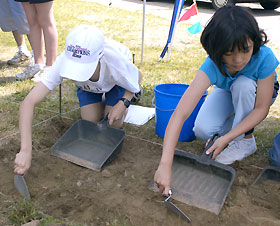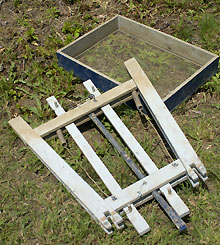For more archives, go to the Advance Archive/Search Page.
Children Unearth The Past
At Historic On-Campus Site
Evan Rouse, 11, carefully scrapes dirt into a pile with his trowel. A small rock catches his eye. "This looks like coal," he says.
"Could be," says another youngster examining the small specimen.
 |
Mark David Jambeck, left, and Nicole Epineda uses tools to look for artifacts in the soil during the archaeological dig at the site of a house once owned by the Farwell family.
|
"I didn't know they had coal back then," Rouse says.
Archaeologist Robert Gradie reminds the children to use their trowels properly. "Remember to start at the outside and scrape the dirt towards the center," he says.
Nearby, Mark David Jambeck, 11, pours a bucketful of dirt through a special screen. "This looks like a tiny piece of brick," he says, picking up a red morsel among the rocks and weeds that remain in the sifter.
Rouse and Jambeck were among a dozen children who explored the world of archaeology this summer during a weeklong camp offered by the Connecticut State Museum of Natural History's Connecticut Archaeology Center and the Kids Are Scientists Too program. The museum is sponsoring archaeology camps for different age groups throughout the summer.
"It's hard, dusty work, and the children are very enthusiastic," says Gradie who is leading the excavation. He teaches courses in archaeology and anthropology at UConn. "They get to see that they can do science: that it's a method of observation and recording."
And the area that the children are excavating is an actual historic site located on the UConn campus.
Cheri Collins, program coordinator and collection manager of the Connecticut Archaeology Center, selected the site with state archaeologist Nicholas Bellantoni. An 18th-century farmhouse stood there until 1976. "We wanted the children digging at a real site, where they were likely to find artifacts," says Collins, who heads the camp. She spent a month researching the site's historic records.
 |
A sifter used during the dig. |
The house, off Route 195, was part of a farm owned by the Farwell family from the 1720's until 1908, when it was sold to George Jacobson of Waterbury. In 1911, Jacobson sold the house and land to the State of Connecticut. It was burned in 1976. The excavation is taking place in the area that would have been right outside the kitchen - the yard where, in colonial times, garbage was thrown out the door, Gradie says.
Collins says the dig is both fun and serious. "We want the children to learn about the science of archaeology and have fun," she says, adding that the excavation is being conducted according to correct archaeological procedures, so that nothing is unduly disturbed.
"We want them to understand how previous cultures dealt with the same problems that we have today, like issues of food and shelter, and living in society," she says.
All eyes are on Gradie, as he moves some dirt from a pile into a dustpan, and then a bucket. "We don't dig randomly and pick things out of the ground," he explains. "Archaeology is a very systematic activity. We record everything."
The children open their notebooks and write up their first observations.
"We need one other bit of information," Gradie says. "We need to know how far down in the ground we found the material." Nicole Pineda, 10, sticks a yellow ruler in the earth. "It's zero to two inches," she says, dusting off her notebook and recording the information.
"I like the digging," Pineda says. "I think we might find some pottery or different things that Farwell had here." She was right. Later that morning, a piece of 18th-century pottery was unearthed.
Jambeck says he likes "looking for stuff that's been here for years, but we never knew about."
That's also what fascinates 9-year-old Riley Clark-Long, as well. "I like finding things that are old and were used by other people," he says. "I think that's cool."

